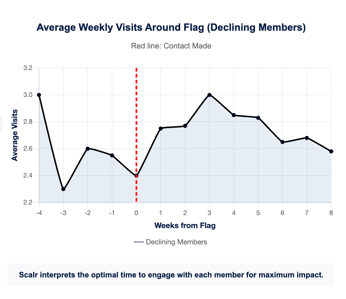The average gym loses 30-40% of its starting member base every year, and traditional approaches center around reactive outreach, generic emails, and basic attendance tracking.
Behavioural analytics allows us to start predicting changes in members at a much deeper level. What if you could identify the exact patterns that lead to disengagement and intervene at the right moment?
New technology linked with drastic AI improvements are revolutionising how forward-thinking gyms approach member retention.
The Problem with Traditional Gym Analytics
Gym management software focuses on operational metrics: attendance, class bookings, payments, and general demographic data. While these metrics are important for day-to-day operations, they're reactive indicators that only tell you what happened after the fact.
Traditional Analytics Tell You:
- How many times someone checked in last month
- Which classes they booked
- When their membership expires
- General demographic information
What Traditional Analytics Miss:
- Why members gradually lose motivation
- When the decline in engagement actually begins
- Which specific behavior changes results in churn
- How to intervene before it's too late
This reactive approach means you're always playing catch-up, trying to win back members who have already mentally checked out.
Behavioural Analytics: The Game Changer
Behavioural analytics goes beyond surface-level data to understand the psychology behind member actions. Instead of just tracking what members do, it analyses how their behavior patterns change over time and what these changes predict about their future engagement.
The Science Behind Behavioural Analytics
Behavioural analytics in fitness is grounded in proven psychological principles:
Loss Aversion: People feel the pain of losing something twice as strongly as they feel the pleasure of gaining it. When members start to lose their fitness momentum, this psychological principle can either drive them away or, when properly leveraged, highly motivate them to re-engage.
Consistency Bias: Humans have a deep psychological need to appear consistent with their past actions and commitments. When behavior patterns break, it signals a fundamental shift in member commitment.
Habit Formation: Research shows that gym habits follow predictable formation cycles. Disruptions in these cycles are early warning signs that can be detected and addressed proactively.
How Behavioural Analytics Predicts Member Churn
Modern behavioural analytics platforms analyse hundreds of micro-signals to build comprehensive member engagement profiles. Here's how it works:
1. Pattern Recognition
The system establishes each member's unique behavioural baseline:
- Preferred workout times
- Frequency patterns
- Class preferences
- Equipment usage
- Social interactions
2. Change Detection
Advanced algorithms continuously monitor for deviations from established patterns through specific behavioural cohorts. Scalr's platform tracks members across seven key behavioural change categories:
Primary Risk Indicators:
- Visit Decline: Gradual decrease in gym visit frequency over time
- Consistency Breaks: Disruption in established workout routines and scheduling patterns
- Cancellations: Increased cancellation rates for pre-booked classes or sessions
- No-Shows: Members who book but fail to attend scheduled activities
Secondary Behavioural Signals:
- Recovery Gaps: Extended periods between workout sessions that exceed member norms
- Gaining Momentum: Positive behavior changes that indicate increased engagement (used for retention reinforcement)
Each cohort represents a distinct behavioural pattern that correlates with different stages of member disengagement. The system automatically categorises members into these cohorts based on real-time behavioural analysis, allowing gym staff to see exactly which members need attention and what type of intervention is most appropriate.
3. Predictive Modelling
Machine learning models analyse these behavior changes against historical data to predict churn probability with remarkable accuracy - often 60-90 days in advance (72 days average).
Real-World Impact: The Numbers Don't Lie
Gyms implementing behavioural analytics are seeing dramatic improvements in retention rates. Here's what the data shows:
Industry Benchmarks:
- Average gym retention rate: 60-70%
- Cost to acquire new member: £150-300
- Lifetime value of retained member: £1,500-3,000
Retention Impact:
- Member lifetime increase: 35 days (318 → 353 days)
- Additional revenue: ~£3,000 from extending average monthly terminations by one month
- LTV increase per member: £140
- Engagement efficiency: Only 6% of members contacted per week, but only when impact is likely to be high
The key to these results? Optimal timing. Scalr interprets the precise moment to engage with each member for maximum impact, whether they're showing signs of declining visits, consistency breaks, or schedule shifts.
The Behavioural Warning Signs Your Gym Should Track
Not all behavioural changes are created equal. Here are the most predictive indicators of member churn:
High-Risk Behavioural Changes:
%20(Medium%20Banner%20(US)%20(Landscape))%20(2).png?width=608&height=304&name=Buyer%20Personas%20(1200%20x%20630%20px)%20(Medium%20Banner%20(US)%20(Landscape))%20(2).png)
Why These Patterns Matter:
Each of these behaviours represents a psychological shift in how members view their fitness journey. Traditional analytics might catch these changes after they've become habits. Behavioural analytics identifies them as they're happening, creating intervention opportunities.
The Technology Behind Modern Behavioural Analytics

Machine Learning Algorithms
Clustering models identify member segments with similar behavior patterns
Time series analysis tracks behavior changes over time
Predictive models forecast future engagement levels
Real-Time Processing
Live data analysis provides immediate insights as behaviours occur
Alert systems notify staff when intervention opportunities arise
Dynamic risk scoring continuously updates engagement metrics

Integration Capabilities
Multi-source data combines activity, external influences, and more
API connectivity works with existing systems
Accessibility provides insights anywhere, anytime
Implementing Behavioural Analytics
Successfully implementing behavioural analytics requires more than just technology - it requires a shift in how your gym approaches member engagement.
Phase 1: Foundation (Month 1)
- Integrate behavioural analytics platform with existing systems
- Establish behavioural baselines
- Train staff on reading insights
- Set up automated alerts
Phase 2: Optimisation (Months 2-4)
- Refine predictive models based on your member base
- Develop targeted intervention strategies
- Create automated engagement campaigns
- Measure and adjust intervention success rates
Phase 3: Advanced Implementation (Months 4-6)
- Implement predictive member lifecycle management
- Develop personalised retention strategies
- Optimise staff workflows around behavioural insights
- Scale successful interventions across all locations
The Human Element: Technology + Personal Touch
The Future is Behavioural
The fitness industry is undergoing a fundamental shift from reactive to predictive member management. Gyms that embrace behavioural analytics now will be the market leaders of tomorrow, while those that stick to traditional approaches will continue to struggle with high churn rates and unsustainable acquisition costs.
The question isn't whether behavioural analytics will become standard in the fitness industry, it's whether your gym will be an early adopter or a late follower.
---------------------------------------------------------------------
⚠️ What NOT to Do: Avoid Common Mistakes
As gyms rush to implement behavioural analytics, several common pitfalls can undermine success:
- Data Overwhelm: Focusing on too many metrics instead of the most predictive indicators
- Generic Interventions: Using the same retention strategies for all at-risk members
- Timing Errors: Intervening too early (annoying members) or too late (after they've mentally checked out)
- Technology-Only Approach: Relying solely on automated systems without human touchpoints
✅ What TO Do: Gain Competitive Advantage
Gyms that master behavioural analytics gain significant competitive advantages:
Immediate Benefits:
- Reduced churn rates by 15-25%
- Increased lifetime value through longer member relationships
- Lower acquisition costs as retention improves
- Enhanced member satisfaction through proactive support
Long-Term Strategic Advantages:
- Data-driven decision making for all business operations
- Predictive capacity planning based on member behavior trends
- Personalised member experiences that build loyalty
- Staff efficiency improvements through targeted interventions
---------------------------------------------------------------------
Getting Started with Behavioural Analytics
Ready to transform your gym's approach to member retention? Here's how to begin:
Immediate Actions:
- Audit your current data collection to understand what behavioural signals you're already capturing
- Identify your biggest retention challenges and the behavioural patterns that might predict them
- Research behavioural analytics platforms that integrate with your existing gym management system
- Pilot test with a subset of your member base to measure impact
Key Questions to Ask Potential Analytics Partners:
- How quickly can the system establish behavioural baselines for existing members?
- What intervention tools are built into the platform?
- How does the system handle data privacy and security?
- What kind of ROI can you expect in the first 6-12 months?
Conclusion: The Time is Now
Member retention has always been the lifeblood of successful gyms, but the tools for achieving it have evolved dramatically. Behavioural analytics represents the biggest leap forward in retention technology in decades, offering unprecedented insight into member psychology and engagement patterns.
The gyms that implement behavioural analytics today will enjoy significant competitive advantages tomorrow. They'll retain more members, generate more revenue, and build stronger communities around their brands.
The future of gym retention isn't about guessing what members need, it's about knowing, predicting, and acting on behavioural insights before members even realise they need support.
Ready to transform your gym's retention strategy with behavioural analytics? Book a demo to see how predictive member insights can revolutionise your business.
Tags:
Behavioural Science, Fitness Technology, Case Studies, Gym Analytics, Member Retention, Industry InsightsSep 19, 2025 2:37:01 PM


-1.png?width=520&height=294&name=Blog%20Background%20(6)-1.png)
Comments